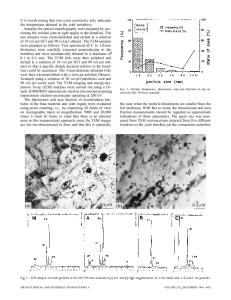Use of microstructural statistics in predicting polycrystalline material properties
- PDF / 317,109 Bytes
- 11 Pages / 612 x 792 pts (letter) Page_size
- 39 Downloads / 300 Views
NTRODUCTION
THE macroscopic behavior of crystalline materials is usually treated in one of two diametrically opposing ways. The first assumes that the material is isotropic, meaning that there is a random orientation of the crystal lattices in uniformly sized and arranged equiaxed grains. The material properties do not vary with direction in this idealized case. The second approach assumes that the material is a perfect, single crystal of known orientation. This means that the physical properties vary in a simple, predictable manner, with their direction based on crystal symmetry and chemistry. Both of these methods can result in analytic solutions to engineering problems and have served as the basis for much of the engineering and scientific progress of the last century. In response to legal, economic, and social pressures, the need has arisen for engineers to use natural resources more efficiently and to produce materials which are optimally engineered for their intended use. This effort includes gaining a better understanding of a material’s inhomogeneity or anisotropy and exploiting these characteristics to fulfill design criteria. More-precise methods of predicting a material’s properties are required in order to achieve this goal. Toward this end, statistical continuum mechanics theories have been developed which use the statistics of a material’s microstructure to more accurately correlate macroscopic response to stimuli. In addition, much work has been done to determine the microstructure resulting from a variety of manufacturing processes. This combination of information allows one to more-correctly choose the production process for a material in order to yield the desired microstructure and material properties. Previous work[1,2] demonstrated that two-point statistics THOMAS A. MASON, Technical Staff Member, is with the Material Science and Technology Division, Los Alamos National Laboratory, Los Alamos, NM 87545. BRENT L. ADAMS, Professor, is with the Department of Materials Science and Engineering, Carnegie Mellon University, Pittsburgh, PA 15213. Manuscript submitted March 17, 1998. METALLURGICAL AND MATERIALS TRANSACTIONS A
of microstructure could be used to provide 75 pct tighter bounds on the elastic properties of a polycrystal. These bounds were found to correlate well with the actual macroscopic elastic properties of the test material, determined from experimental acoustic measurements. This article will provide more detail regarding the collection and application of two-point microstructural statistics in statistical continuum mechanical theories and will explore ways to better engineer materials via processing routes. While the material property of interest in this study is elasticity, or, more specifically, the elastic stiffness and compliance tensors, the development is sufficiently general to lend itself to other tensoral material properties. The basic formulae of several statistical continuum mechanical theories will be presented along with any required preliminary concepts. Data derived fro
Data Loading...











